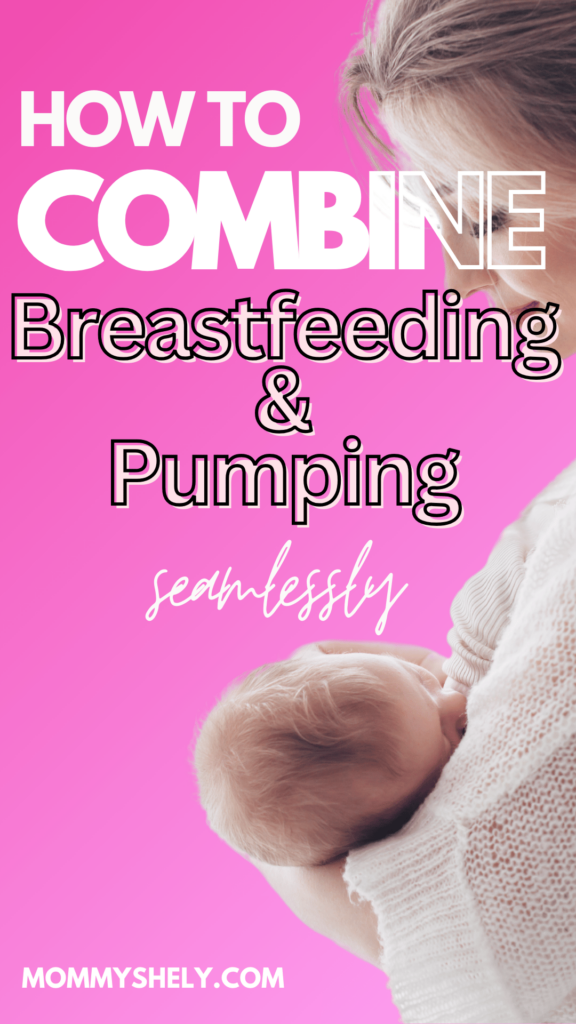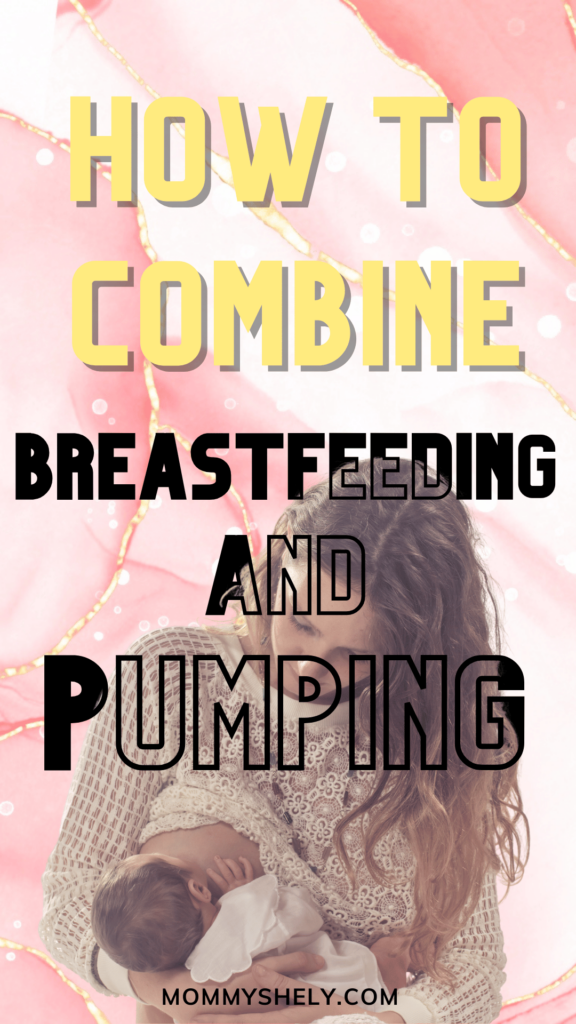Combining breastfeeding and pumping is a great way to ensure your baby receives all the benefits of breast milk while giving yourself the flexibility you need.
Whether you’re heading back to work or building up a freezer stash, learning how to combine breastfeeding and pumping effectively can make your life a whole lot easier.
Whether you’re a first-time mom or a seasoned pro, breastfeeding and pumping can bring their own set of challenges.
In this guide, you’ll learn how to breastfeed and pump at the same time, build a solid milk stash, and develop a breastfeeding and pumping schedule that works for you and your baby.
Pin For Later!

As an Amazon Associate I earn from qualifying purchases. This post may contain affiliate links.
Reasons for Combining Breastfeeding and Pumping
Boosting Milk Supply
Breast milk production operates on supply and demand. The more milk you draw out, the more your breasts will produce.
Combining breastfeeding with pumping can help stimulate milk production and increase your overall supply.
Ensuring Your Baby is Well Fed
If your baby has trouble latching or doesn’t drink enough from breastfeeding alone, having extra milk on hand can be a lifesaver.
You can follow up breastfeeding with a bottle to ensure your baby gets all the nutrition they need.
Helping with Breastfeeding Discomfort
Using a breast pump can provide relief from common breastfeeding discomforts like clogged milk ducts, engorgement and mastitis.
Making Feeding More Flexible
Bottle feeding with expressed milk lets your partner get involved in feeding, giving them a chance to bond with the baby.
And let’s face it, sometimes a mom just needs a break. Whether it’s running errands, visiting a day spa, or just taking a nap, pumped milk gives you the flexibility to recharge.

Challenges of Combining Breastfeeding and Pumping
While there are many benefits to combining breastfeeding and pumping, it’s also important to be aware of a few common challenges that might come up along the way:
Struggles with Milk Supply
Some moms might experience low milk supply or have trouble getting enough milk production going.
Don’t worry; there are plenty of strategies and support to help increase your supply.
Time Commitment
Breastfeeding and pumping both take up a lot of time. It can be tough to fit pumping sessions into your busy day, but it’s definitely doable.
Balancing breastfeeding and pumping sessions can be tricky. It takes careful planning and prioritization to fit both into your routine effectively.
Emotional Challenges
Feeling overwhelmed is normal. From feelings of guilt to frustration, it’s important to recognize and address these emotions.
And if you’ve reached a point where breastfeeding is becoming emotionally or physically too much, you might be ready to explore how to stop breastfeeding and transition at your own pace.
Tips on Combining Breastfeeding and Pumping
These practical tips will help you create a routine that supports your milk supply, fits your lifestyle, and keeps both you and your baby happy:
Find the Best Breastfeeding and Pumping Schedule
Find your sweet spot when it comes to combining breastfeeding and pumping.
Some moms swear by pumping after breastfeeding sessions to ensure enough milk supply, while others find success in pumping between feedings.
Experiment and see what works best for you and your baby.
Invest in a Quality Breast Pump
Your breast pump is your sidekick in this adventure, so make sure it’s up to the task.
Choose a high-quality electric breast pump that suits your needs. A hands-free or double pump is great for more efficient milk removal while multitasking.
Create a Pumping Sanctuary
Designate a cozy corner of your home as your pumping oasis. Deck it out with comfy pillows, soothing music, and maybe even some photos of your little one for extra motivation.
Turning pumping sessions into mini relaxation breaks can make the whole experience more enjoyable.
Get into a Pumping Routine
Consistency is key when it comes to combining nursing and pumping.
Try to pump around the same time each day to signal to your body that it’s time to produce milk. Plus, having a regular breastfeeding and pumping schedule can help you stay organized in all this chaos.
Maximize Milk Production
Channel your inner dairy queen by incorporating lactation-boosting foods and drinks into your diet. Oatmeal, Brewer’s Yeast, and plenty of water can work wonders in keeping your milk supply flowing.
Build a Stash
Build up your freezer stash of pumped milk for those moments when you need to be away from your baby. Read all about handling and storing breast milk here.
Collect Every Drop
Use milk collector, such as the Haakaa cup, on the opposite breast while breastfeeding.
This simple yet effective method allows you to catch any letdown milk that would otherwise be lost in a nursing pad or nursing bra.
Keeping Your Spirits Up
Breastfeeding and pumping can be physically and emotionally demanding.
To stay motivated, seek support and encouragement from loved ones or online communities.
Remember, feeding your baby is a full-time job in itself, so give yourself credit for all your hard work.

FAQ About Breastfeeding and Pumping Combo
How many times a day should I pump?
A good starting point is to aim for around 8-12 pumping sessions per day, which matches the typical feeding frequency for newborns.
As your baby grows and your milk supply regulates, you might find that you need to pump less often.
Can I breastfeed and pump at the same time?
Absolutely! Some multitasking mamas find it convenient to pump one breast while breastfeeding on the other side.
This can be a time-saving technique, especially for busy moms who need to maximize their pumping sessions while still feeding their baby.
Do I have to pump if I’m exclusively breastfeeding?
While pumping may not be necessary for every breastfeeding mom, there are situations where it can be beneficial.
Pumping allows you to build up a freezer stash of milk for times when you need to be away from your baby, whether it’s for work, appointments, or some much-needed self-care.
Additionally, pumping can help maintain milk supply and relieve engorgement if your baby isn’t feeding as frequently as usual.
How long after breastfeeding should I pump?
It’s generally recommended to wait at least 30-60 minutes after breastfeeding before pumping.
This allows your breasts time to refill and ensures a more effective pumping session.
how to bottle feed a breastfed baby?
The best way to bottle feed a breastfed baby is by using a paced feeding technique.
This method mimics the natural flow of breastfeeding and helps prevent nipple confusion.
What is the best schedule for pumping while breastfeeding?
The best pumping schedule depends on your baby’s feeding patterns, your comfort, and your lifestyle.
If your baby is exclusively breastfeeding, try to mimic their feeding patterns when scheduling pumping sessions.
For example, if your baby typically feeds every 2-3 hours during the day, you can aim to pump every 2-3 hours as well. This helps maintain a similar frequency and ensures regular milk removal.
How to increase milk supply through pumping after breastfeeding?
One trick that really works is to pump more often. This will signal your body that it needs to produce more milk.
Another tip is double pumping. It’s like hitting two birds with one stone – you empty both breasts at the same time, giving your body extra encouragement to make more milk.
Another thing to try is power pumping. This involves pumping for shorter, more frequent intervals over the course of an hour to stimulate milk production.
How much milk should I be pumping?
Well, it really depends on your baby’s individual feeding habits. Every baby is unique, and some may need to feed more often than others.
Your goal is to pump enough milk to fulfill your baby’s daily needs. Read this to understand if your baby is eating enough.
Combining breastfeeding and pumping isn’t just about feeding your baby – it’s also about empowering yourself as a mom.
Establishing a consistent schedule for both breastfeeding and pumping is crucial for maintaining milk supply and managing your precious time.
Remember to celebrate your successes along the way, whether it’s reaching a pumping milestone or perfectly thawing the right amount of milk without any waste.
Remember, every ounce counts and every feeding is a win. Whether you’re nursing, pumping, or both—you’re doing an amazing job.
With love,
Shely




